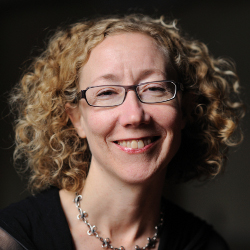
Catherine Bonier University of Pennsylvania 2012-2013 Dissertation Research Fellow
The Philadelphia Area Center for the History of Science’s Dissertation Research Fellowship allowed me to spend a month of focused research in Philadelphia’s archives. My dissertation examines Benjamin H. Latrobe’s Philadelphia waterworks of 1801 within the context of eighteenth century ideas of health, nature, and balance. Philadelphia was not only the site of the first American municipal waterworks, it was also the center of medical inquiry in America around 1800. The waterworks, constructed in response to Philadelphia’s yellow fever outbreaks of the 1790s, may have been the earliest municipal public health infrastructure in America. During the month sponsored by PACHS, I was able to access manuscript material held by the Library Company, the College of Physicians, the American Philosophical Society, and the Historical Society of Pennsylvania. Thanks to PACH’s Dissertation Research Fellowship, I was able to find material that will assist tremendously with the completion of my dissertation.
I am currently investigating the ways in which the condition of early republican Philadelphia was considered to be imbalanced and inflamed, and the ways in which the waterworks, in both its technological and its architectural conception, may have been planned to rebalance the city. In some cases this balance was medical or hydrological, and in some cases aesthetic. At the Historical Society of Pennsylvania I found unpublished writings by Latrobe which confirm that he was closely considering the geological conditions of the city even as he planned a water distribution system housed in a dramatic neoclassical building which was not particularly well suited to the topography of the land, or the requirements of the steam engine it enclosed. At HSP I also found, with the assistance of an expert and helpful staff, several late eighteenth century maps that uniquely represent the city’s topography and hydrology, allowing me to confirm my suspicions about Latrobe’s design of the waterworks. Thanks to the generosity of PACHS, the time I was able to spend conducting archival research gave me a much better sense of how the city’s health was understood in relationship to its environment during the late eighteenth century. In the Vaux papers at the APS, I found accounts that tried to give the yellow fever a precise location in the city, and that described the population as the “feuel” that fed the disease. At the College of Physicians, I was able to read the unpublished and often contradictory opinions of many of the city’s most prominent physicians about the environmental conditions which they believed were contributing to the city’s epidemic fevers. The Nicholas Chervin Survey of 1821 was a series of questions sent to fifty-six Philadelphia physicians, specifically asking whether they believed yellow fever to be contagious. The collected replies were found in a sealed lectern at the College of Physicians in 1990. Responses reflect the divided opinions of the medical establishment, and provided descriptions of the various environmental problems that physicians believed favored the disease, particularly heat, pestilence, and miasmata. That the disease vector for this disease is the Aedes aegypti mosquito would not be discovered until the late-19th century. The fact that the mosquito didn’t travel very far meant that the disease most often appeared along Philadelphia’s swampy riverfront on the Delaware. This was the densest area of settlement and near the docks, which already had a reputation for poverty, filth, vice, and immigrants. Blaming bad airs and heat did provide a logical reason for building a waterworks, which would not only help clean the city, but also, in the thinking of the time, cool the air.
The waterworks was not just a public health intervention, it was also a civic monument. The Library Company’s newspapers from circa 1800 allowed me to compare the various ways that the waterworks project was promoted, which seems to have differed significantly depending on the political slant of the journal. These materials also give a glimpse in their advertisements of the various entertainments that sprung up near the waterworks, indicating the ways the building become a center for civic activity. In a rare stroke of luck, when I visited the Library Company, I also learned that they had recently acquired a previously unseen plan of the waterworks dating from the early nineteenth century. The Historical Society of Pennsylvania holds a beautiful series of original renderings of the waterworks by Latrobe himself, dating from 1799, as well as more recent prints and postcards. The APS has in their collection beautifully rendered plans by Latrobe’s student William Strickland, never executed, to convert the waterworks into a “Temple of Science,” an astronomical observatory to be on a par with those of Europe. I am very grateful to The Philadelphia Area Center for the History of Science for supporting my research into Philadelphia’s impressive archives. It was a wonderful opportunity to comb through collections that include maps, drawings, letters, and manuscripts that helped me gain a fuller picture of the first American waterworks within the context of public health and civic life.